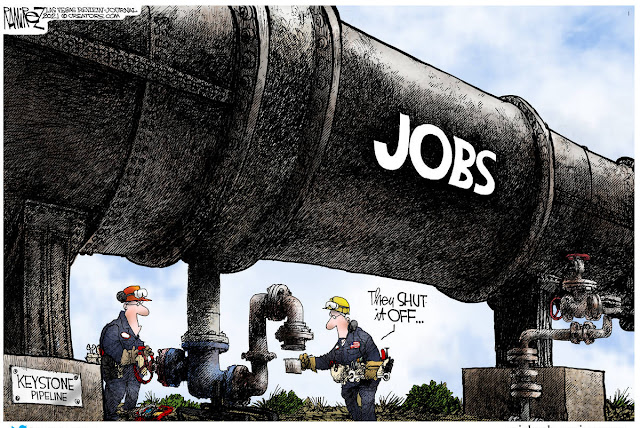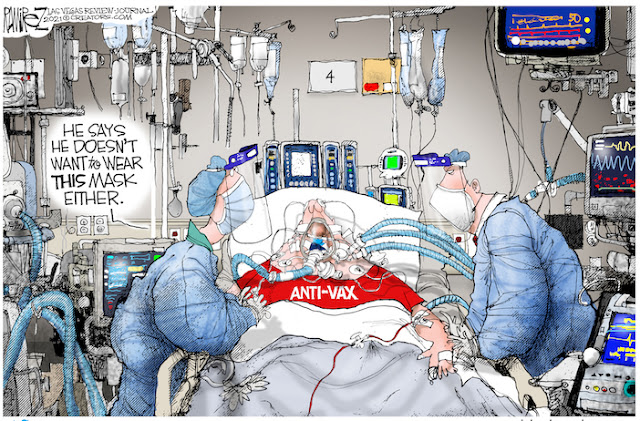As far as I can tell, Michael Ramirez can draw any damn thing he wants.
I mean that in both senses: he can get away with almost any concept and he has the drawing ability to execute that concept.
Ramirez seems unfazed by regular death threats in reaction to his controversial cartoons. He notes that his first death threat came from his parents when he told them he was giving up plans for medical school to become a political cartoonist.
But more importantly for the purposes of this blog, Ramirez seems able to capture any subject he chooses. For example, he can beautifully draw the perspective inside a confined plane cabin, if that's what his idea calls for...
... but at the same time, he can effectively draw perspective in the wide open sky outside.
He's great at capturing heavy industrial structures...
He is fearless about drawing from any angle...
... or taking on historical and anthropological themes:
When you ask Ramirez how he was trained to draw such a diverse array of subjects, he responds, "I was always curious about how everything works.... I like breaking the pieces down, finding out the components, how everything works, and then putting them back together." That instinct, combined with a natural talent for recreating whatever he saw, accounted for the vast majority of his art training.
Ramirez says he may have 15 ideas a day and writes them down on cocktail napkins or other stray bits of paper to keep track of them.
Sometimes when he has a little too much time on his hands, he will draw something fanatical like this:
But this tight, trompe l'oeil drawing is not what impresses me most about his work. I'm more impressed by pictures like the following, where Ramirez simply drew two backsides against a sky.
95% of today's political cartoonists, if they had the courage to attempt such an angle, might draw these backs as two rectangles. Notice how Ramirez infuses character into these backs, to make the drawing work-- the sagging, weary shoulders, the stylized, leaning bodies with their foreshortened heads and big butts-- these weren't taken from a photograph or learned in an anatomy class. The variety of the linework adds volume, the contrast between the blue and white is very effective, and the whole drawing is staged thoughtfully-- for example, Uncle Sam respectfully takes off his battered hat and places it on his knee. A lot of nice visual touches contribute to the message of the cartoon.
 |
| Thousands of cartoonists have drawn thousands of grim reapers, yet when it's Ramirez's turn, he puts aside the cookie cutter and makes a fresh effort to produce something worthwhile. |
Unlike the super-realistic door lock and wood grain in the cartoon above, in this next cartoon, Ramirez takes liberties with the human form. Uncle Sam has an impossibly high waist and gorilla length arms. These exaggerations help meld the two figures together. For me, these types of drawings work better than intense realism.












15 comments:
Beautiful stuff.
Ramirez, like Davis and Fluharty, (and Drucker et al) has funny in his fingerbones.
And maybe that is where Art Young's albeit effective work falls short, the drawing itself is as dogmatic as the political assertions; it feels Brutalist; so lacking in fun, I find it hard to think of it as cartooning.
That door is practically worthy of Wyeth.
Gawd, even his napkin sketches are better than most of my finishes. What a talent.
Great talent. As you said, political cartoons artists in France do not seem to think "drawing" and more "message". I wish some look at Ramirez’ work.
Bad example. If you really look, he uses photographs. Draws over top of them with a tablet. It's just that his caricatures are his own. But half his props are photos. Sometimes his entire background. After you see it it's obvious. If you're willing to look past your idolatry.
Michael Ramirez is the only artist in the world I want to draw like. No exaggeration or ass kissing in that statement. I have been stealing from him for years. In fact after I draw the face of any character I ask myself WWMD. What would Michael do? True story. Dear anonymous your comments are typical of online hit and runs. It's quite possible you don't really know how to draw. Once you do know a little about draftsmanship you realize how great Michael's drawing ability is... pretty much just like Apatoff said. ps who doesn't use photographs? He actually uses them perfectly and has the insane ability to say ten thousand words beyond the reference.
As Mr Fluharty said, it’s not a problem to work from photography if it adds value to the illustration. Like in some mangas, the contrast between complex photorealistic background and humorous characters is very efficient here. And these images have to be drawn quite quickly so photography is a great help. I usually don’t like very much photography reference in illustration, but Mr Ramirez does a great job here.
MORAN-- Agreed.
Kev Ferrara-- "funny in his finger bones" is a good way to put it. The artists you mention all seem to draw with a distinctive line, which is naturally funny as it twists and turns and emerges. I think Richard Thompson and Jeff MacNelly were artists in that same elite category.
I agree that Art Young is not as "fun," and he wasn't a natural draftsman like Ramirez, but that doesn't mean he wasn't an extremely potent political cartoonist. His tropes in the two examples I offered-- the glutton at cliff's edge and the giant lizard-- remain just as powerful and timeless today, a century later. That's extremely rare.
Zoe-- Well, it certainly displays a great amount of technical skill, although that's not my favorite of Ramirez's super powers.
Li-An-- Ramirez is carried in a huge number of papers around the world, so he does have a large audience. But I agree that more artists could learn from focusing on the quality of his drawing.
Anonymous-- I think you're wrong. If you look at Ramirez's preliminary sketches (which were obviously done without photos) the full DNA of his art is on display. You can see how Ramirez got from start to finish, relying solely on his extraordinary talent.
My point in the discussion of the cartoon with Uncle Sam and the Bahamas is that I'm sure Ramirez looks at photo reference for the details of palm trees or Mayan architecture or an airplane cabin, but he reshapes and personalizes those photographic facts, taking complete control of them. It's easy to see with our naked eye how his line totally transforms any data from photography and makes every inch of those drawings his own.
I actually questioned Mr. Ramirez about this precise issue, the scope of his use of photographs in two cartoons where his backgrounds seemed crazy realistic. (One involved reflections in a large balloon and the other involved a detailed background of the Senate chambers.) In both cases he walked me through how he achieved the effects he employed, and persuaded me that photographs never, ever appear in his cartoons.
Finally, as I tried to suggest in my discussion of that hyper detailed lock and key cartoon, Mr. Ramirez's "photographic" realism is hardly what I admire most about his drawing. For me, realism is just a game he plays, showing off his technical skill when he has too much time on his hands. I don't value it nearly as much as I value his creative work. I featured his art in this post because I admire his strong personal choices in his linework, layouts, designs, composition, etc. which are far from any suspicion of undue photographic influence.
Thomas Fluharty-=- Wow, that's quite an endorsement.
Li-An-- Agreed. The issue of photography remains a sensitive one, despite the fact that Cezanne, Van Gogh, Degas, Bonnard, Gauguin, Toulouse Lautrec and Eakins all used photographs without a hint of embarrassment. As I noted in an earlier post in this series, some of my favorite illustrators, such as Bernie Fuchs and Austin Briggs, used photo reference. It's all a question of what you do with it. If you use it as a substitute for talent because you can't draw a caricature of a face, it quickly becomes pathetic.
@David Apatoff : a good example of an artist who used A LOT of photographies s Moebius/Giraud - see my post here https://www.li-an.fr/histoire-bd/human-form-moebius/
A great talent to appreciate and learn from.
Really good artist, but you Americans have a nutty take on vaccines and politics generally
Li-An-- Thanks to the link to your excellent post on the use of photography by Moebius/Giraud. It was a revealing piece of scholarship, and very well done! My hat is off to the Moebius fans who helped you collect that information.
I am accustomed to artists using photo reference, but I was surprised by how Moebius used very obvious, easily accessible sources (movie stills from Dr. Zhivago, book covers, anatomy books etc.) and how completely he relied upon them for particular figures / scenes. You've really helped to shape my notion of the artist.
Tracye-- Definitely!
Anonymous-- I can't disagree with you.
Post a Comment